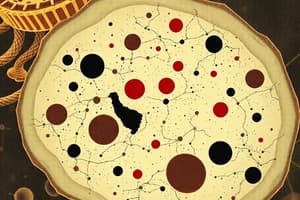Podcast
Questions and Answers
What is the main function of the plasma membrane?
What is the main function of the plasma membrane?
To regulate the movement of materials in and out of the cell
What is the primary site of metabolic reactions and cellular activities within the cell?
What is the primary site of metabolic reactions and cellular activities within the cell?
Cytoplasm
What is the difference between passive and active transport?
What is the difference between passive and active transport?
Passive transport occurs without energy input, while active transport requires energy input
What is the primary function of mitochondria in the cell?
What is the primary function of mitochondria in the cell?
What is the role of ribosomes in protein synthesis?
What is the role of ribosomes in protein synthesis?
What is the function of lysosomes in the cell?
What is the function of lysosomes in the cell?
What are the stages of the cell cycle?
What are the stages of the cell cycle?
What is the purpose of signaling pathways in cellular communication?
What is the purpose of signaling pathways in cellular communication?
Flashcards are hidden until you start studying
Study Notes
Cell Biology
Cell Structure
- Plasma membrane: semi-permeable membrane that separates the cell from its environment
- Composed of phospholipid bilayer and proteins
- Regulates movement of materials in and out of the cell
- Cytoplasm: jelly-like substance inside the cell membrane
- Site of metabolic reactions and cellular activities
- Composed of water, salts, sugars, and organelles
- Organelles: specialized structures within the cell
- Examples: mitochondria, ribosomes, endoplasmic reticulum, lysosomes, Golgi apparatus
Cell Membrane Functions
- Passive transport: movement of molecules across the cell membrane without energy input
- Types: diffusion, osmosis, facilitated diffusion
- Active transport: movement of molecules across the cell membrane with energy input
- Types: pumping, phagocytosis, pinocytosis
Cellular Organelles
- Mitochondria: generate energy for the cell through cellular respiration
- Convert glucose into ATP (adenosine triphosphate)
- Ribosomes: site of protein synthesis
- Read messenger RNA (mRNA) to assemble amino acids into proteins
- Endoplasmic reticulum (ER): network of membranous tubules and cisternae
- Involved in protein synthesis, lipid synthesis, and detoxification
- Lysosomes: contain digestive enzymes to break down and recycle cellular waste
- Golgi apparatus: complex of flattened sacs and tubules
- Involved in protein modification, sorting, and secretion
Cell Cycle and Division
- Cell cycle: sequence of stages a cell undergoes from birth to division
- Interphase (G1, S, G2) and mitosis (M)
- Mitosis: process of cell division resulting in two daughter cells
- Stages: prophase, metaphase, anaphase, telophase, cytokinesis
Cellular Communication
- Signaling pathways: mechanisms by which cells respond to signals from their environment
- Types: hormonal, electrical, and mechanical signaling
- Cell adhesion: interactions between cells and their environment
- Important for tissue structure, development, and function
Cell Biology
Cell Structure
- Plasma membrane: a semi-permeable membrane that separates the cell from its environment, composed of a phospholipid bilayer and proteins, and regulates the movement of materials in and out of the cell.
- Cytoplasm: a jelly-like substance inside the cell membrane, where metabolic reactions and cellular activities take place, and is composed of water, salts, sugars, and organelles.
- Organelles: specialized structures within the cell that perform specific functions, including mitochondria, ribosomes, endoplasmic reticulum, lysosomes, and Golgi apparatus.
Cell Membrane Functions
- Passive transport: movement of molecules across the cell membrane without energy input, including diffusion, osmosis, and facilitated diffusion.
- Active transport: movement of molecules across the cell membrane with energy input, including pumping, phagocytosis, and pinocytosis.
Cellular Organelles
- Mitochondria: generate energy for the cell through cellular respiration, converting glucose into ATP (adenosine triphosphate).
- Ribosomes: the site of protein synthesis, reading messenger RNA (mRNA) to assemble amino acids into proteins.
- Endoplasmic reticulum (ER): a network of membranous tubules and cisternae involved in protein synthesis, lipid synthesis, and detoxification.
- Lysosomes: contain digestive enzymes to break down and recycle cellular waste.
- Golgi apparatus: a complex of flattened sacs and tubules involved in protein modification, sorting, and secretion.
Cell Cycle and Division
- Cell cycle: a sequence of stages a cell undergoes from birth to division, including interphase (G1, S, G2) and mitosis (M).
- Mitosis: the process of cell division resulting in two daughter cells, with stages including prophase, metaphase, anaphase, telophase, and cytokinesis.
Cellular Communication
- Signaling pathways: mechanisms by which cells respond to signals from their environment, including hormonal, electrical, and mechanical signaling.
- Cell adhesion: interactions between cells and their environment, important for tissue structure, development, and function.
Studying That Suits You
Use AI to generate personalized quizzes and flashcards to suit your learning preferences.





